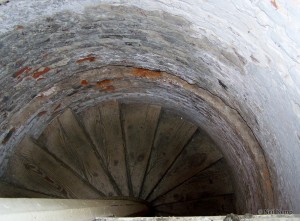
This week’s tour of Kent’s historical sights took me to Deal Castle, just south of Deal town centre.
Deal Castle may not meet everyone’s view of an English castle. It isn’t large and it doesn’t hold a high defensive position above an area it was built to defend. Deal Castle is set low to the ground, very low, and as such you don’t become aware of its presence until you are actually there. The sunken feature of the castle is quite deliberate, ensuring that the castle presented far less target areas for any enemy to attack than would normally be expected for structures built prior to this period. Its squat, rounded bastions were designed to deflect incoming cannon balls, and acted as platforms from which to fire its increasingly sophisticated artillery pieces.
 Given its size, purpose and location, Deal Castle could, with justification, be more accurately referred to as an artillery fort. A traditional medieval castle structure, with high, thick walls, and rectangular towers, would have proved useless when faced with a bombardment of cannon-fire. The solution was this concentric fortress, with a series of curving walls in a flower pattern, overlapping to provide firing angles, with a low central tower, surrounded by a series of six semi-circular bastions, encircled by a ditch and a curtain wall with six projecting lobes. Cannons were mounted at every level, allowing a devastating range of simultaneous firing from the tower, inner bastions, and outer bastions. The design of the castle meant that a total of 66 guns could be mounted in these areas. Should the outer defences have been breached, the castle is equipped for close-quarter defence, with 145 embrasures for firearms.
Given its size, purpose and location, Deal Castle could, with justification, be more accurately referred to as an artillery fort. A traditional medieval castle structure, with high, thick walls, and rectangular towers, would have proved useless when faced with a bombardment of cannon-fire. The solution was this concentric fortress, with a series of curving walls in a flower pattern, overlapping to provide firing angles, with a low central tower, surrounded by a series of six semi-circular bastions, encircled by a ditch and a curtain wall with six projecting lobes. Cannons were mounted at every level, allowing a devastating range of simultaneous firing from the tower, inner bastions, and outer bastions. The design of the castle meant that a total of 66 guns could be mounted in these areas. Should the outer defences have been breached, the castle is equipped for close-quarter defence, with 145 embrasures for firearms.
The castle at Deal is one of a chain of coastal forts built by order of Henry VIII; most being constructed between 1539 and 1542. This action was prompted by Henry’s fear of an invasion by European Catholic forces, after the alliance between France and the Holy Roman Empire, the two European super-powers of the day.
Work commenced on Deal Castle in 1539 and was completed in 1540, a phenomenal achievement. The fort guarded the sheltered anchorage of the “Downs” – the stretch of water between the shore and the hazardous Goodwin Sands, a notorious graveyard to shipping. Three forts were situated within 2 miles of each other: Sandown (now demolished), a mile to the north of Deal, and Walmer, a mile to the south. These forts were originally linked by a two mile long earthen “fosse” or rampart, strengthened by small earth “bulwarks” or forts. No trace of these linkages now remains. The whole scheme for the defence of the “Downs” was completed in the autumn of 1540. The complete chain of coastal defences, which included coastal forts at Calshot, Camber, Portland and Pendennis, was finished in 1545.
In the event, no invasion ever came; even the Spanish Armada of 1588 passed Deal by. The castle did see heavy fighting in the English Civil War. Originally held for Parliament, it was taken by forces from the rebel Royalist fleet, in 1648, and held out for nearly three months before being forced to surrender to Parliamentarian forces under the command of colonel Rich.
Despite the damage caused during this engagement, restoration works immediately after the Civil War and during the 18th and 19th centuries, ensured that Deal Castle today is one of the finest Tudor artillery castles in England, its exterior remaining pretty much as it would have looked like in the 16th century.
 Whilst its exterior is spectacular to view, the inside of Deal Castle is little more than an empty shell. Its spartan interior is probably an evocative reminder of the conditions that the garrison would have to have endured. Deal Castle was a functioning defensive fort; It wasn’t built for comfort, although later improvements in accommodation would have undoubtedly made life easier for the fort’s captain and his officers. Its many dark, winding passages remain rather spooky to this day and one imagines it must have been a rather gloomy habitat when lit only by torchlight. Presumably little in the way of light would have been allowed near the barrels carefully stacked in the gunpowder store!
Whilst its exterior is spectacular to view, the inside of Deal Castle is little more than an empty shell. Its spartan interior is probably an evocative reminder of the conditions that the garrison would have to have endured. Deal Castle was a functioning defensive fort; It wasn’t built for comfort, although later improvements in accommodation would have undoubtedly made life easier for the fort’s captain and his officers. Its many dark, winding passages remain rather spooky to this day and one imagines it must have been a rather gloomy habitat when lit only by torchlight. Presumably little in the way of light would have been allowed near the barrels carefully stacked in the gunpowder store!
There is now no longer any access to the top floor of the castle or, by extension, the roof, which is regrettable. The last time any easy access remained to this level was during the Second World War, when Deal Castle served as an observation post.
Deal Castle is well worth a visit. The exterior is spectacular and the interior, whilst being pretty much bare, is atmospheric, with many passages, nooks and crannies to explore. A small display area highlights the history of the castle through the years.
I shall now move along the coast and explore Walmer Castle, which although built at the same time as Deal Castle, has been altered so extensively over the years that it has now acquired the air of a comfortable home rather than that of a functioning military fort. It will be interesting to compare the differences between Deal and Walmer Castles, but one thing remains certain. Whatever Deal Castle may lack in interior comfort, it is a fantastically preserved example of a Tudor coastal fort and remains largely unchanged from the day, back in 1540, when it became one of the jewels of Henry’s defensive fortifications of England.
Neil Kemp is a keen and passionate amateur historian and prize winning photographer who lives in Margate, on the North Kent coast in the United Kingdom. Before retiring he worked both with and at Margate Museum, overseeing budgets on a number of historical projects.











